How Does Water Temperature Affect What Koi Fish Eat?
This post may contain affiliate links.
Water temperature is the single most critical factor determining what, when, and how much koi fish should eat. As cold-blooded creatures, koi fish experience dramatic changes in their metabolism, digestive capacity, and nutritional requirements based on water temperature fluctuations. Understanding this fundamental relationship is essential for any serious koi keeper who wants to maintain healthy, vibrant fish year-round.
Many pond owners unknowingly harm their koi by failing to adjust feeding practices according to temperature changes. This comprehensive guide explores the science behind temperature-dependent feeding and provides practical strategies for optimizing your koi’s nutrition throughout all seasons.
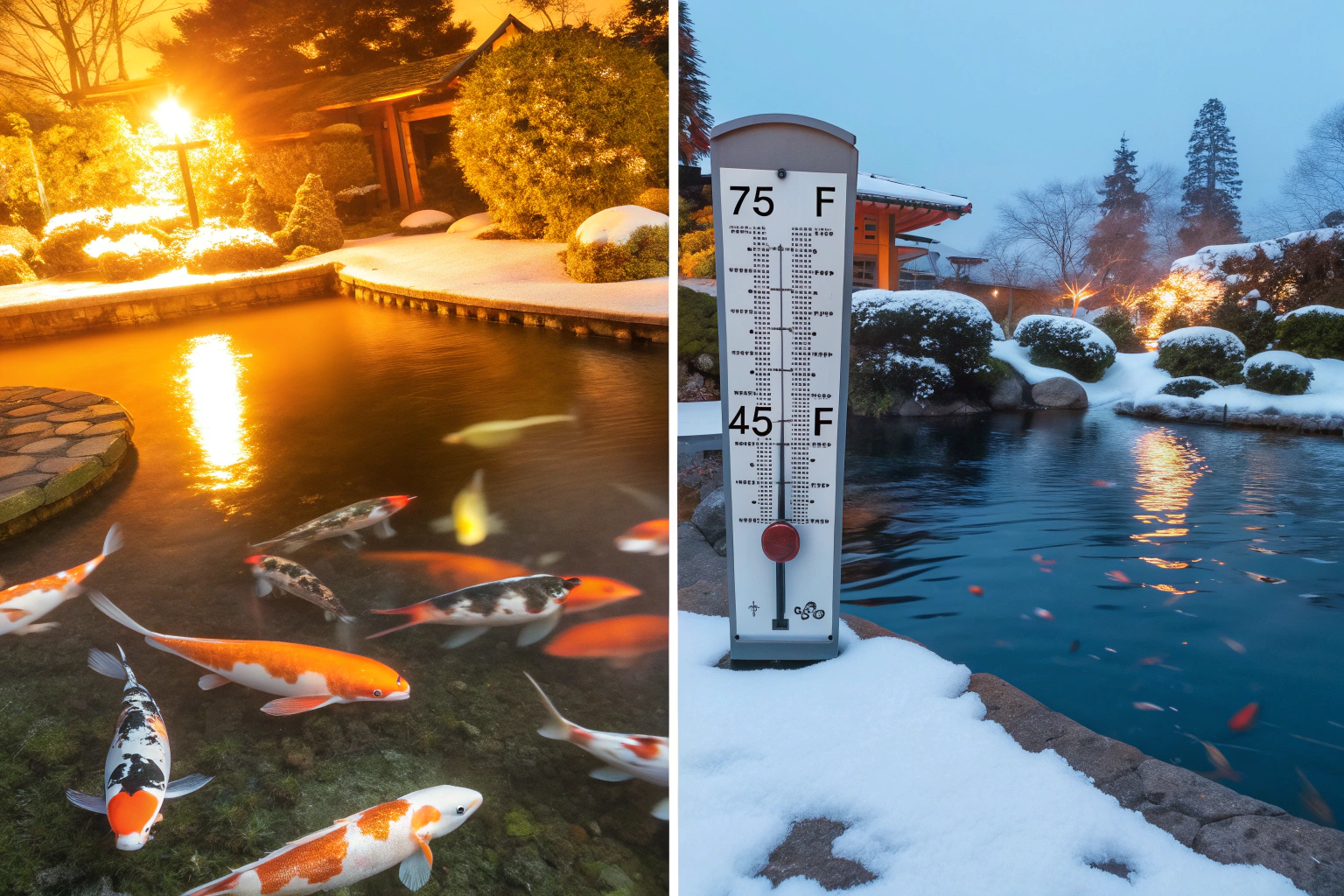
The Science of Temperature and Koi Metabolism
Koi fish are poikilothermic animals, meaning their internal body temperature matches their surrounding water temperature. This biological characteristic creates a direct correlation between water temperature and metabolic rate, fundamentally affecting how koi process and utilize food.
Metabolic Rate Changes Across Temperatures
At 75°F (24°C): Koi metabolism operates at peak efficiency
- Maximum enzyme activity for protein digestion
- Optimal nutrient absorption rates
- Fastest growth and healing capabilities
- Highest immune system function
At 60°F (15°C): Metabolism reduces to approximately 50% of peak levels
- Decreased digestive enzyme production
- Slower nutrient processing
- Reduced growth rates
- Compromised immune response
At 45°F (7°C): Metabolism drops to less than 10% of summer levels
- Minimal enzyme activity
- Severely limited digestive capacity
- Near-dormant state (torpor)
- Extremely vulnerable immune system
This temperature-dependent metabolism directly impacts koi fish dietary requirements and feeding strategies throughout the year.
Temperature Zones and Feeding Recommendations
Optimal Feeding Zone: 70-78°F (21-26°C)
This temperature range represents ideal conditions for koi feeding and growth:
Recommended Diet:
- High-protein pellets (35-42% protein content)
- Multiple daily feedings (2-4 times)
- Variety of foods including vegetables, fruits, and live foods
- Maximum portion sizes (what fish can consume in 5-10 minutes)
Nutritional Focus:
- Growth and development
- Color enhancement
- Immune system support
- Reproductive health
Feeding Schedule:
- Morning feeding (7-9 AM)
- Midday feeding (12-2 PM)
- Evening feeding (5-7 PM)
- Optional late evening snack for young koi
Active Feeding Zone: 60-69°F (15-21°C)
Moderate temperatures require adjusted feeding approaches:
Recommended Diet:
- Medium-protein pellets (28-35% protein)
- Twice daily feeding
- Easily digestible foods
- Reduced portion sizes
Key Considerations:
- Slower digestion requires longer intervals between meals
- Monitor for undigested food in the pond
- Focus on maintenance rather than growth
- Supplement with vegetables for fiber
Transition Zone: 50-59°F (10-15°C)
This critical zone requires careful feeding adjustments:
Recommended Diet:
- Low-protein, wheat germ-based foods (15-25% protein)
- Once daily feeding or every other day
- Smaller, easily digestible pellets
- Minimal treats or supplements
Special Precautions:
- Feed only on warmer days within this range
- Stop feeding immediately if temperature drops suddenly
- Use sinking pellets to reduce waste
- Monitor koi behavior closely for feeding readiness
Danger Zone: Below 50°F (10°C)
Complete feeding cessation is required in this temperature range:
Why No Feeding:
- Digestive enzymes become inactive
- Food will remain undigested and rot internally
- Risk of bacterial infections and death
- Immune system cannot fight off food-related illness
Understanding these temperature-based feeding guidelines prevents common mistakes that can prove fatal to koi fish.
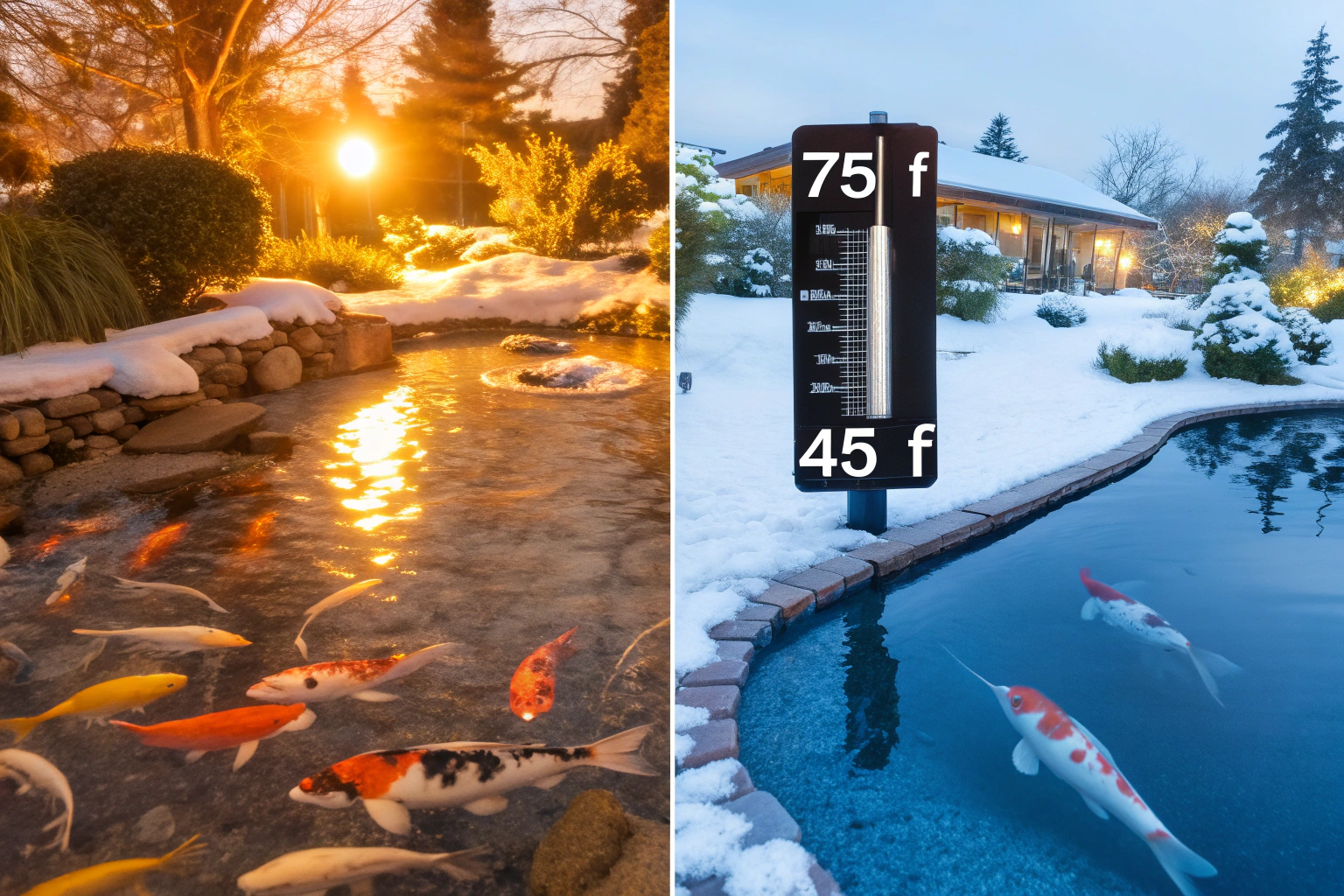
How Temperature Affects Digestive Enzymes
Enzyme Activity and Temperature Correlation
Koi fish rely on specific digestive enzymes to break down proteins, carbohydrates, and fats. These enzymes exhibit temperature-dependent activity levels:
Protease Enzymes (Protein Digestion):
- Optimal activity: 72-78°F (22-26°C)
- 50% activity: 60-65°F (15-18°C)
- Minimal activity: Below 55°F (13°C)
Amylase Enzymes (Carbohydrate Digestion):
- Peak efficiency: 68-75°F (20-24°C)
- Reduced function: 55-67°F (13-19°C)
- Nearly inactive: Below 50°F (10°C)
Lipase Enzymes (Fat Digestion):
- Maximum activity: 70-76°F (21-24°C)
- Decreased efficiency: 58-69°F (14-21°C)
- Severely limited: Below 55°F (13°C)
Implications for Food Selection
These enzyme activity patterns explain why different foods work better at different temperatures:
High Temperatures (70°F+): Can handle high-protein, complex foods Moderate Temperatures (55-69°F): Better suited for easily digestible carbohydrates Low Temperatures (Below 55°F): Should not receive any food

Seasonal Feeding Strategies Based on Temperature
Spring Feeding Transition (50-65°F / 10-18°C)
As water temperatures rise from winter lows, gradually reintroduce feeding:
Week 1-2 (50-55°F):
- Wheat germ pellets every 3-4 days
- Very small portions
- Monitor for proper digestion
Week 3-4 (55-60°F):
- Daily small feedings
- Introduce easily digestible vegetables
- Increase portion sizes gradually
Week 5+ (60°F+):
- Return to regular feeding schedule
- Transition to higher-protein foods
- Resume multiple daily feedings
Summer Peak Feeding (70-80°F / 21-27°C)
Optimal temperatures allow for maximum feeding frequency and variety:
Daily Feeding Schedule:
- Early morning: High-protein growth pellets
- Midday: Vegetables or color-enhancing foods
- Evening: Maintenance pellets or treats
- Night (optional): Small snack for juvenile koi
Food Variety:
- Premium koi pellets (35-45% protein)
- Fresh vegetables (peas, lettuce, sweet potato)
- Occasional fruits (watermelon, oranges)
- Live or frozen foods (bloodworms, brine shrimp)
This intensive feeding supports rapid growth and optimal koi fish health and coloration.
Fall Temperature Decline (65-50°F / 18-10°C)
Preparing koi for winter requires careful feeding adjustments:
Early Fall (60-65°F):
- Reduce feeding frequency to twice daily
- Switch to moderate-protein foods (25-30%)
- Eliminate hard-to-digest treats
Mid Fall (55-60°F):
- Once daily feeding
- Wheat germ-based pellets only
- Monitor weather forecasts for temperature drops
Late Fall (50-55°F):
- Feed every other day
- Very small portions
- Prepare to stop feeding completely
Winter Dormancy (Below 50°F / 10°C)
Complete feeding cessation is essential for koi survival:
- No feeding regardless of fish behavior
- Remove any uneaten food from previous feedings
- Focus on maintaining water quality
- Monitor koi for signs of distress
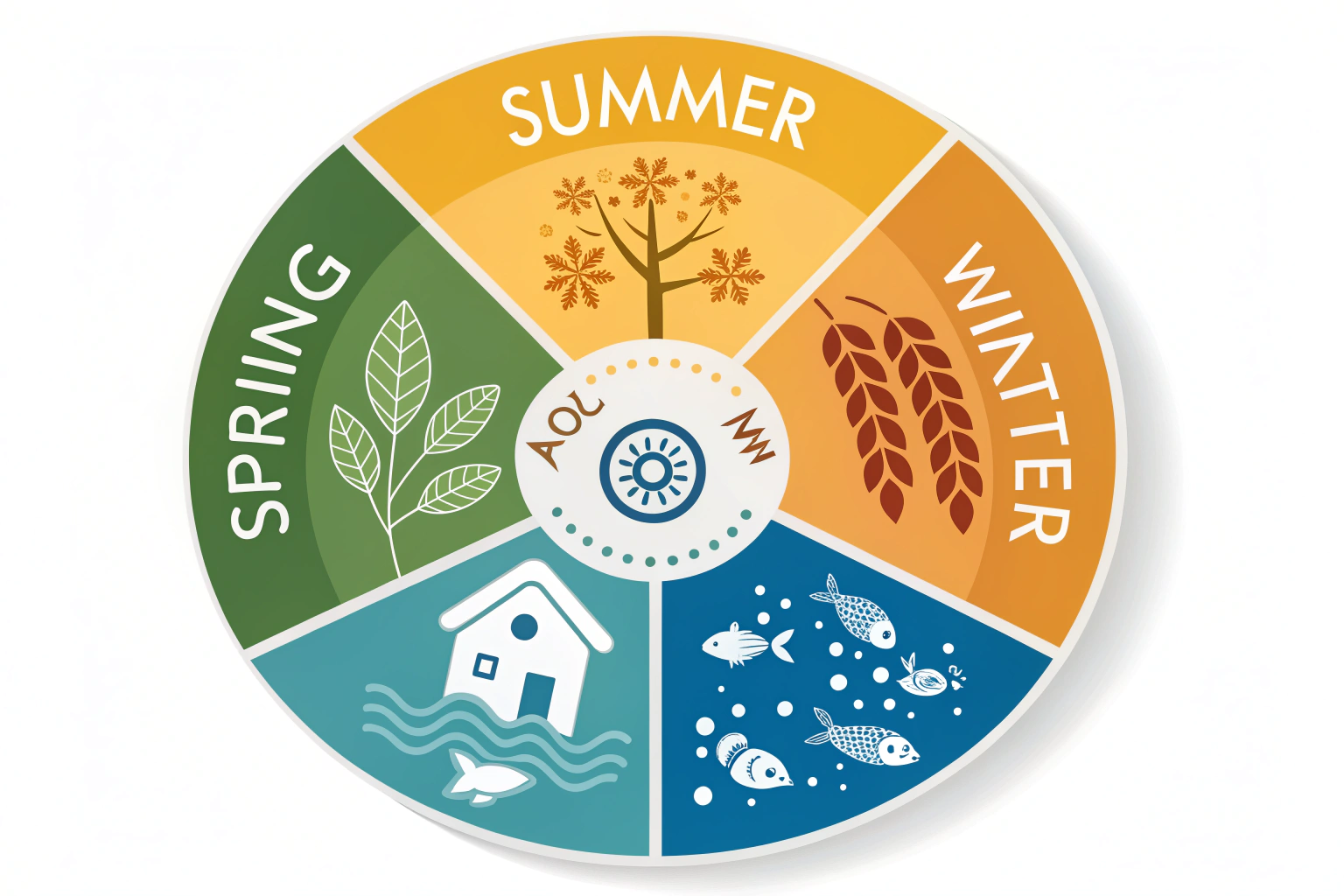
Water Temperature Monitoring for Optimal Feeding
Essential Equipment
Digital Pond Thermometer:
- Accuracy within ±1°F
- Min/max memory function
- Wireless monitoring capabilities
- Waterproof construction
Temperature Data Logging:
- Track daily temperature fluctuations
- Identify feeding opportunity windows
- Plan seasonal feeding transitions
- Monitor climate change impacts
Best Practices for Temperature Monitoring
Daily Measurements:
- Check temperature at the same time daily
- Measure at mid-depth in the deepest part of pond
- Record temperatures in a feeding log
- Note any sudden changes
Seasonal Patterns:
- Establish baseline temperatures for your location
- Track first and last feeding dates annually
- Identify optimal feeding windows
- Plan food inventory accordingly
Understanding your local pond temperature patterns enables precise feeding management.
Impact of Sudden Temperature Changes
Temperature Shock and Feeding
Rapid temperature fluctuations create additional feeding challenges:
Sudden Warming (10°F+ increase in 24 hours):
- Don’t immediately resume normal feeding
- Wait 2-3 days for koi to adjust
- Start with small portions of easily digestible food
- Monitor for stress-related behaviors
Sudden Cooling (10°F+ decrease in 24 hours):
- Stop feeding immediately
- Remove any uneaten food from pond
- Don’t resume feeding until temperatures stabilize
- Watch for signs of temperature shock
Seasonal Weather Variability
Climate change has increased temperature variability, requiring adaptive feeding strategies:
Spring Warm Spells: Early warm periods followed by cold snaps Fall Temperature Swings: Unseasonably warm days in late fall Winter Thaws: Brief warming periods during winter months
Adaptive Strategy: Always base feeding decisions on current water temperature, not calendar dates or recent weather patterns.
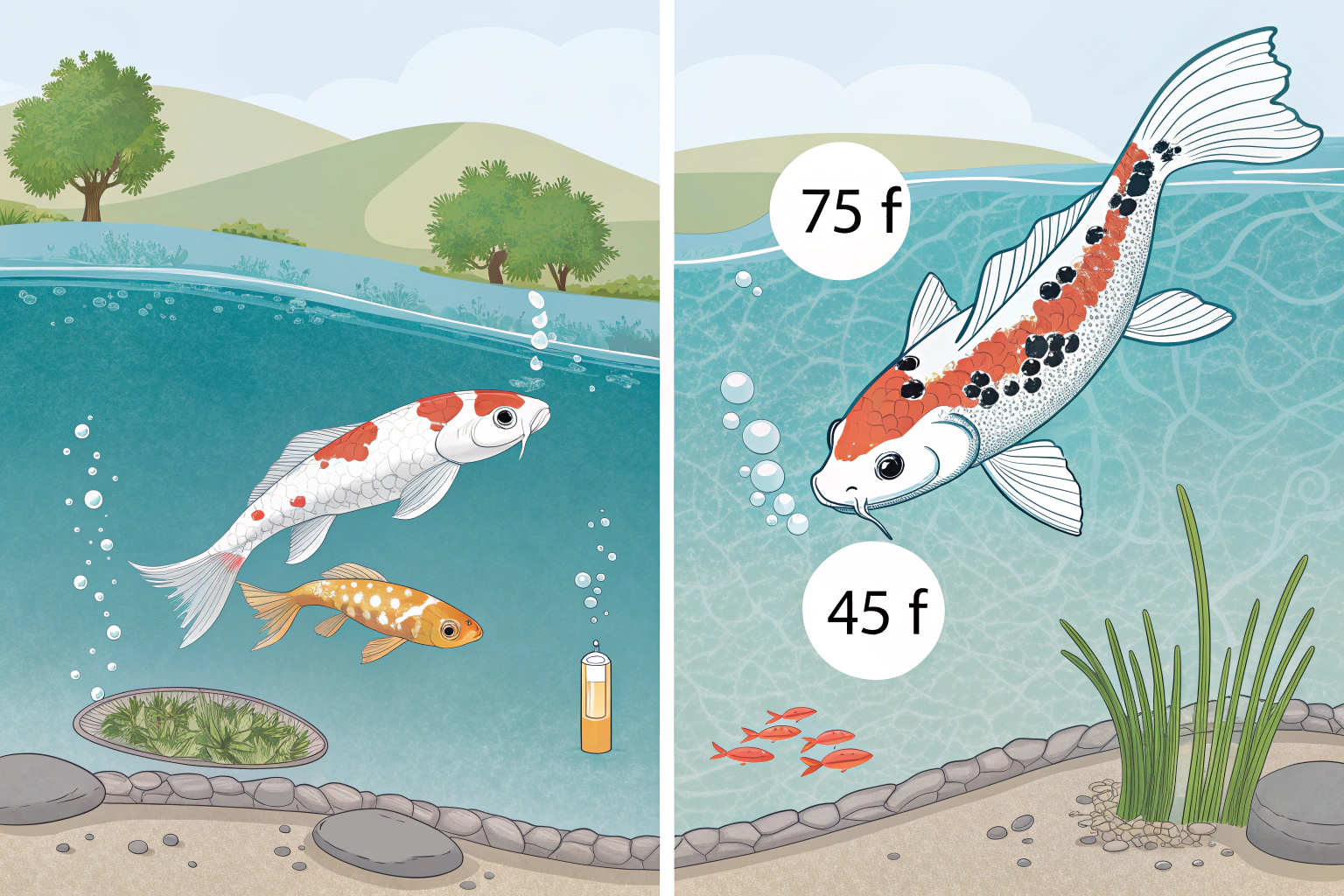
Regional Considerations for Temperature-Based Feeding
Northern Climates (Zones 3-5)
Harsh winters with extended freezing periods:
Feeding Season: May through October Peak Feeding: June through August Transition Periods: May and September-October Dormant Period: November through April
Special Considerations:
- Shorter feeding seasons require intensive summer nutrition
- Early fall preparation crucial for winter survival
- Ice formation affects pond temperature regulation
- Consider pond heaters for temperature stability
Southern Climates (Zones 8-10)
Mild winters allow extended feeding seasons:
Year-Round Feeding: Possible in many areas Reduced Feeding: December through February Peak Feeding: March through November Minimal Dormancy: Brief periods only
Advantages:
- Longer growth seasons
- Consistent koi health maintenance
- Less dramatic dietary transitions
- Reduced winter mortality risks
Temperate Regions (Zones 6-7)
Variable climates require flexible approaches:
Feeding Season: April through November Peak Season: May through September Variable Winters: Some feeding possible during warm spells Weather Monitoring: Essential for feeding decisions
Understanding your specific climate zone impacts on koi care ensures appropriate feeding strategies.
Advanced Temperature Management Techniques
Pond Heating Systems
Strategic use of pond heaters can extend feeding seasons:
Benefits:
- Prevent complete pond freezing
- Maintain minimum temperatures for limited feeding
- Reduce temperature shock events
- Protect koi during extreme weather
Considerations:
- High energy costs
- Equipment maintenance requirements
- Environmental impact
- Return on investment analysis
Thermal Mass and Pond Design
Proper pond construction affects temperature stability:
Deep Water Zones:
- Minimum 4-6 feet deep
- Provide stable temperature refuges
- Reduce rapid temperature fluctuations
- Support natural temperature gradients
Thermal Mass Elements:
- Large rocks and boulders
- Concrete structures
- Earth berms
- Strategic landscaping
Microclimate Management
Creating favorable microclimates around ponds:
Wind Protection:
- Reduces heat loss through evaporation
- Minimizes temperature fluctuations
- Protects feeding areas from disturbance
- Improves overall pond stability
Solar Gain Optimization:
- Strategic placement for maximum sun exposure
- Use of heat-absorbing materials
- Reflection management
- Seasonal shading considerations
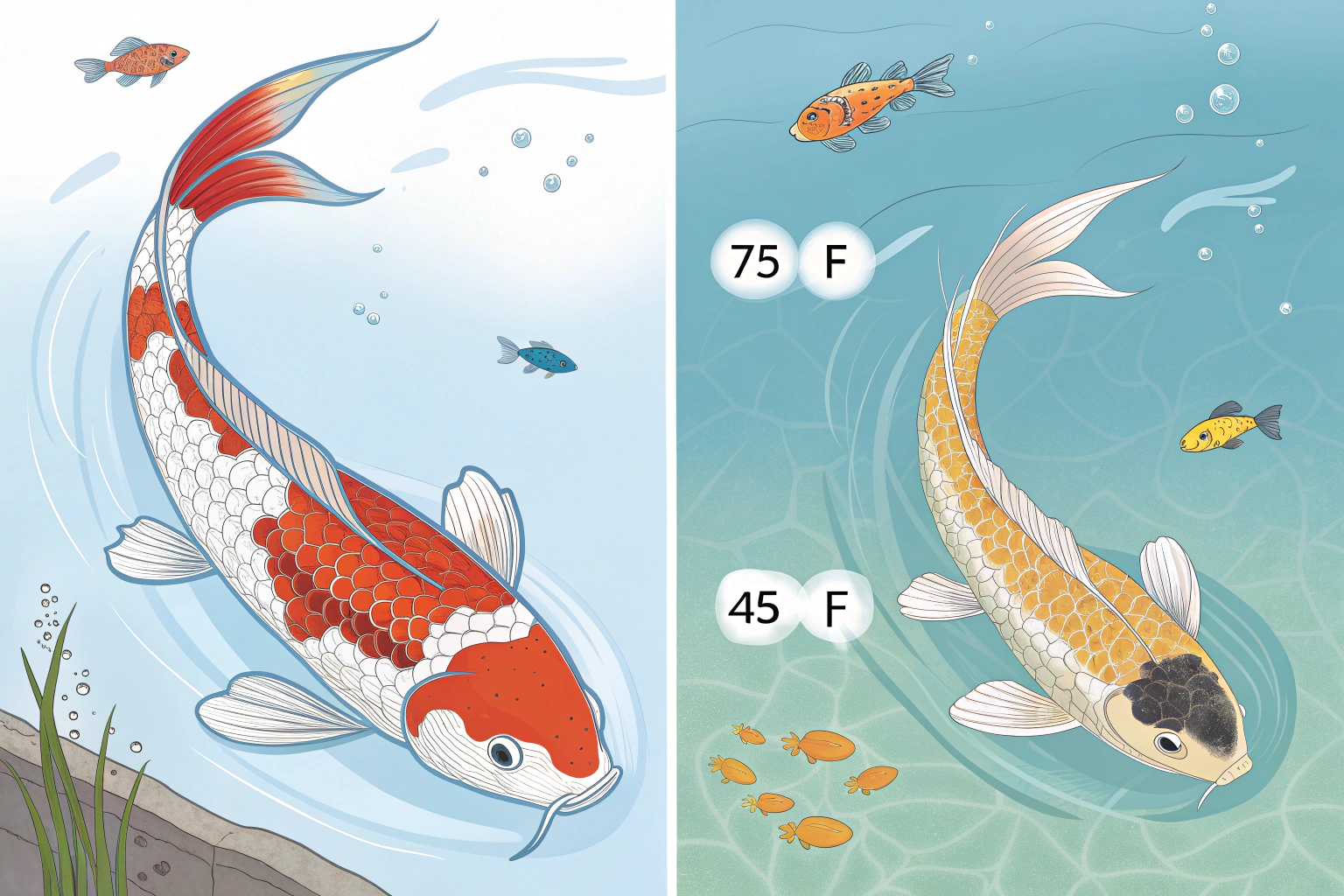
Common Temperature-Related Feeding Mistakes
Mistake 1: Calendar-Based Feeding
Many koi keepers feed based on dates rather than actual water temperature:
Problem: Weather patterns vary significantly year to year Solution: Always use thermometer readings for feeding decisions Result: Improved koi health and reduced mortality
Mistake 2: Ignoring Gradual Temperature Changes
Slow temperature drops can be as dangerous as sudden changes:
Problem: Feeding continues as metabolism slows Solution: Monitor trends, not just current temperatures Result: Prevention of digestive complications
Mistake 3: Overfeeding During Temperature Transitions
Koi may appear hungry even when their digestion is compromised:
Problem: Food accumulates in digestive tract Solution: Reduce portions during transition periods Result: Healthier fish and cleaner water
Mistake 4: Using Wrong Food Types for Temperature
Summer foods are inappropriate for cooler water conditions:
Problem: High-protein foods can’t be digested in cool water Solution: Stock temperature-appropriate foods year-round Result: Better digestion and fish health
Water Quality Interactions with Temperature
Temperature Effects on Water Chemistry
Water temperature affects multiple water quality parameters:
Dissolved Oxygen:
- Higher temperatures = Lower oxygen capacity
- Affects koi appetite and metabolism
- Influences feeding timing and portions
- Requires aeration system adjustments
Ammonia Toxicity:
- Increases with temperature
- More dangerous in warm water
- Affects feeding frequency decisions
- Requires enhanced filtration in summer
Bacterial Activity:
- Beneficial bacteria slow in cold water
- Affects waste processing capacity
- Influences feeding quantity decisions
- Requires seasonal filtration adjustments
Feeding and Water Quality Management
Temperature-appropriate feeding supports water quality:
Proper Feeding Benefits:
- Reduces organic waste production
- Minimizes ammonia spikes
- Supports beneficial bacteria populations
- Maintains clear, healthy water
Overfeeding Consequences:
- Increased waste production
- Ammonia and nitrite spikes
- Algae blooms
- Fish stress and disease
Understanding these water quality and feeding interactions is crucial for successful pond management.
Nutritional Science Behind Temperature Effects
Protein Requirements Across Temperatures
Warm Water (70°F+):
- High protein needs (35-45%)
- Rapid growth and tissue repair
- Active immune system support
- Enhanced color development
Moderate Temperatures (55-69°F):
- Reduced protein needs (25-35%)
- Maintenance-level nutrition
- Slower growth rates
- Basic immune support
Cool Water (50-54°F):
- Minimal protein requirements (15-25%)
- Survival-mode nutrition
- No growth expected
- Compromised immune function
Carbohydrate Utilization
Temperature affects how koi process different energy sources:
High Temperatures: Efficiently process complex carbohydrates Moderate Temperatures: Better suited for simple carbohydrates Low Temperatures: Wheat germ provides easily digestible energy
Fat and Lipid Considerations
Essential fatty acids remain important across temperatures:
Warm Weather: Higher fat content supports rapid growth Cool Weather: Moderate fat levels for energy storage Cold Weather: Minimal fat intake due to poor digestion
Economic Implications of Temperature-Based Feeding
Cost-Effective Feeding Strategies
Understanding temperature effects saves money:
Reduced Food Waste:
- Appropriate portions for temperature conditions
- Less uneaten food in pond
- Extended food storage life
- Lower overall feed costs
Health Cost Savings:
- Fewer temperature-related illnesses
- Reduced veterinary expenses
- Lower fish mortality rates
- Extended koi lifespans
Seasonal Food Inventory Management
Spring: Stock wheat germ transition foods Summer: Invest in high-quality growth pellets Fall: Prepare winter transition foods Winter: Minimize food storage requirements
Strategic koi feeding cost management maximizes value while maintaining fish health.
Future Considerations: Climate Change and Feeding
Changing Temperature Patterns
Global climate change affects koi feeding:
Longer Growing Seasons: Extended feeding periods in northern regions Temperature Volatility: More frequent sudden changes requiring adaptive feeding Extreme Weather Events: Heat waves and cold snaps affecting feeding schedules Seasonal Shift Timing: Earlier springs and later falls changing traditional patterns
Adaptive Management Strategies
Flexible Feeding Protocols: Temperature-based rather than calendar-based decisions Enhanced Monitoring: Real-time temperature tracking systems Diverse Food Inventories: Multiple food types for varying conditions Emergency Preparedness: Plans for extreme weather events
Conclusion: Mastering Temperature-Dependent Koi Nutrition
Water temperature serves as the master regulator of koi fish nutrition, dictating what foods they can digest, when they should eat, and how much nutrition they require. The fundamental principle is simple: as water temperature changes, so must your feeding strategy.
Successful koi keeping requires understanding that these beautiful fish are completely dependent on their thermal environment for basic biological functions. By matching your feeding practices to water temperature conditions, you provide the foundation for healthy, long-lived koi that will bring years of enjoyment to your pond.
The investment in proper temperature monitoring equipment and temperature-appropriate foods pays dividends in fish health, reduced mortality, and overall pond success. Remember that comprehensive koi care extends beyond feeding to include understanding the complex relationships between temperature, metabolism, and nutrition.
Your koi’s survival and prosperity depend on your ability to adapt their diet to changing thermal conditions. By following these temperature-based feeding guidelines, you’re not just feeding fish – you’re providing species-appropriate care that honors their biological needs and ensures their continued health and beauty.
Temperature awareness transforms koi keeping from guesswork into a science-based practice that consistently produces healthy, vibrant fish. Master this fundamental relationship, and you master one of the most critical aspects of successful koi pond management.
For comprehensive pond management strategies and detailed feeding schedules based on your local climate conditions, explore our complete guide to temperature-based pond management throughout the seasons.
